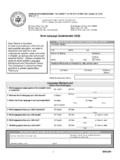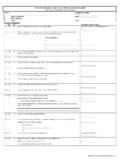Transcription of THE ‘SCHOOL AND PROGRAM’ QUESTIONNAIRE - OECD
1 1 AnnexThe school and Program QUESTIONNAIRE was divided into three parts: Part I: Background questions about the school Part II: Questions about Upper Secondary Schools (Human Resources, Aspects of Functioning, Feedback, Stakeholders, Information and Communication Technology) Part III: Program QUESTIONNAIRE (Questions related to programmes)THE school AND PROGRAM QUESTIONNAIREANNEX 1 56 OECD 2004 ANNEX 157 OECD 2004 school AND PROGRAM QUESTIONNAIREI nternational Generic VersionOECD International Survey of Schools at the Upper Secondary Level ORGANISATION FOR ECONOMIC CO-OPERATION AND DEVELOPMENT school NameSite AdressCity/town/villageRegion/state/prov inceZip code :Respondent:Phone:<Country name> school ID:ANNEX 1 56 OECD 2004 ANNEX 157 OECD 2004 school AND PROGRAM QUESTIONNAIREPREFACEWhat is this survey about?
2 This survey is being administered in 18 OECD countries to compare how upper secondary education is provided. The QUESTIONNAIRE asks for information about: The educational programs offered in your school site; The school s resources; Teachers; The use of information technology and the obstacles in this area; The contacts of the school with higher education and the world of work; Some pedagogical and administrative will the information be used?Your information will help reveal disparities of resource distribution particularly for new technologies both within and between countries. You will receive a summary of the information collected in your country so that you may compare your own situation to other schools in the country where upper secondary education is filling out this QUESTIONNAIRE you also contribute to Education at a Glance, one of the leading educational publications of the Organisation of Economic Co-operation and Development.
3 Using comparative statistics, OECD in co-operation with the Member countries identifies and develops indicators and international benchmarks in key issues in education to help policy makers who seek to improve their countries education further information on OECD s activities and publications related to education you may want to consult and should you respond to this QUESTIONNAIRE ?The QUESTIONNAIRE should be completed by the <principal >or designate. Some of the questions ask information about which you may want to consult staff members in your school . Once you have this information, the QUESTIONNAIRE should take about 45 minutes to you do not know an answer precisely, your best estimation will be adequate for the purposes of this answers will be kept confidential.
4 Thank 1 58 OECD 2004 ANNEX 159 OECD 2004 PRELIMINARY NOTEWe ask about this school sitePart I of this QUESTIONNAIRE (Questions 1 6) refers to the school your school has other school sites as well, please exclude these from your answers. In this QUESTIONNAIRE school always refers to the school site sampled for this ask about <upper secondary education>Part II of this QUESTIONNAIRE (Questions 7 to 28) refers to the whole of the <ISCED 3 programs > in your some of the programs or parts of the programs offered at your school fall outside the <ISCED definition of upper secondary education>, exclude this from your answers as far as possible ( , by estimating or pro-rating for the relevant student population).We ask about < programs >Part III of this QUESTIONNAIRE (Questions 29 to 33) refers to the <upper secondary> programs listed in Question 1.
5 These questions should be answered separately for each <ISCED 3> program offered at your school site. If you have more than one <ISCED 3> program in your school , fill in Part III of the QUESTIONNAIRE separately for each program you offer at your school should you mark your answer?There are three types of answers in this QUESTIONNAIRE : In some questions (Q2 and Q4) the response alternatives are printed in separate rows and you must choose one of them. In these questions you should answer by putting an in the (like this: ) You will be reminded by the instruction: Mark only one of the circles. ) In many questions you should answer by ticking () the box ( ) of the best answer in each row. You will be reminded of this by the instruction Tick one box in each row. Some questions require you to write in text, numbers or percentages.
6 For these questions you should write your answer on the line provided (____). You will be reminded in the cell, if you are expected to estimate a percentage as your answer (_____%).ANNEX 1 58 OECD 2004 ANNEX 159 OECD 2004 PART I: BACKGROUND QUESTIONS ABOUT THE SCHOOL1. What levels of education are offered at your school site?Tick one box in each row. a. <Country name for primary education (ISCED Level 1)>1 Yes2 Nob. <Country name for lower sec. education (ISCED Level 2)>1 Yes2 Noc. <Country name for ISCED Level 4>1 Yes2 Nod. <Country name for ISCED Level 5 >1 Yes2 Noe. <Country name for ISCED 3 Program 1>1 Yes2 Nof. <Country name for ISCED 3 Program 2>1 Yes2 Nog. <Country name for ISCED 3 Program 3>1 Yes2 Noh. <Country name for ISCED 3 Program 4>1 Yes2 Noi. <Country name for ISCED 3 Program 5>, Yes2 No2.
7 Is your school a <public> or a <private> school ?Mark only <public> school <This is a school managed directly or indirectly by a public education authority, government agency, or governing board appointed by government or elected by public franchise.>1A <private school > <This is a school managed directly or indirectly by a non-government organisation; , a church, trade union, businesses, other private institutions.>23. About what percentage of your total funding for a typical school year comes from the following sources?a. Government (includes departments, local, regional, state and national) %b. Student fees or school charges paid by parents %c. Benefactors, donations, bequests, sponsorships, parent fund raising%d. Other %Total 100 %ANNEX 1 60 OECD 2004 ANNEX 161 OECD 20044.
8 Which of the following best describes the area in which your school is located? Mark only one. <A metropolitan area is a large city with the surrounding settlements well integrated in the urban public transportation system>A <village, hamlet or rural area> (fewer than 3 000 people)1A <small town> (3 000 to about 15 000 people)2A <town> (15 000 to about 100 000 people)3A <city> (100 000 to about 1 000 000 people)4 Close to the cultural/business/shopping center of a <city> with over 1 000 000 people5 Elsewhere in the <metropolitan area> of a city with over 1 000 000 people65. How many students were enrolled in your school as of <the end of the first month of this school year>?BoysGirlsa. Total enrolment in the schoolb. Enrolment in <Country name for ISCED 3 Program 1>c. Enrolment in <Country name for ISCED 3 Program 2>d.
9 Enrolment in <Country name for ISCED 3 Program3>e. Enrolment in <Country name for ISCED 3 Program 4>f. Enrolment in <Country name for ISCED 3 Program 5>, For each type of position listed, provide the number of staff (full-time and part-time) currently working in your full-time person is one who is employed for more than 90 per cent of the statutory working time. A part-time employee is one employed for less than 90 per cent of the statutory working timeFill in the number of full-time and part-time persons for each a full-time person is working in more than one position ( a librarian, or deputy principal with teaching duties), include that person in the category where he/she spends the larger part of the statutory working time. INCLUDE TEMPORARY PERSONNEL AS WELL!In the whole schoolFull-timePart-timea.
10 school management personnel (principal, deputy principals)b. Classroom teachers (directly involved in instructional practice)c. Teacher aides (non-professional personnel who provide instruction or support teachers in providing instruction)d. Professional support personnel ( , guidance counselors, librar-ians, psychologists, nurses, social workers, speech therapists)e. Other support personnel ( , secretaries, bookkeepers, caretakers, cleaners, gardeners, etc.)ANNEX 1 60 OECD 2004 ANNEX 161 OECD 2004 PART II: QUESTIONS ABOUT <UPPER SECONDARY> EDUCATION7. What percentage of the teachers currently teaching at the <upper secondary level> ..a. are temporaries?<a person employed for a fixed term not longer than one school year> %%of all full-timeof all part-time%%of all full-timeof all part-timeb.
















